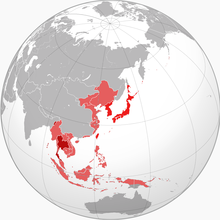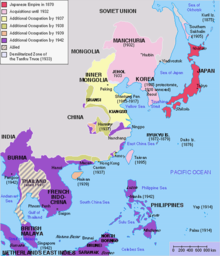Japanese colonial empire
The territorial conquests of the Japanese Empire in the Western Pacific Ocean and East Asia began in 1895 with its victory over Qing China in the First Sino-Japanese War.The extent of Japanese governance was restricted to the naichi (excepting Karafuto Prefecture, which was annexed by the Soviet Union); the Nanpō and Ryūkyū Islands were returned to Japan by the US in 1968 and 1972 respectively.However, this effort was less an initial step toward colonial expansion than it was a reassertion of national authority over territories traditionally within the Japanese cultural sphere.[6] At the start of the twentieth century the rate of population increase in Japan was seen as a potential problem for the Japanese government, and colonial expansion into Korea and Manchuria was seen as a possible solution.In the late 19th and early 20th centuries, various Western countries competed for influence, trade, and territory in East Asia, and Japan sought to join these modern colonial powers.Taking advantage of the Russian Civil War, the Imperial Japanese Army occupied northern Sakhalin between 1920 and 1925;[13] afterwards Japan retained favorable coal and oil concessions therein until 1944.After the end of the war the Treaty of Versailles formally recognized the Japanese occupation of former German colonies in Micronesia north of the equator.The islands became important staging grounds for Japanese air and naval offensives during the Pacific War but were lost to American military action between 1943 and 1945.After emerging victorious against Qing China in the First Sino-Japanese War, Japan was ceded the southern part of the Liaodong Peninsula under the terms of the Treaty of Shimonoseki.The Japanese Army initially sponsored a policy of forced industrialization modeled after the Five Year Plan in the Soviet Union[21] but subsequently private capital was used in a very strongly state-directed economy.The Soviet Union declared war on Japan on 8 August 1945 under the agreement at the Yalta Conference and invaded Manchukuo from the north through Outer Manchuria and Mongolia.Kohli's conclusion is that "the highly cohesive and disciplining state that the Japanese helped to construct in colonial Korea turned out to be an efficacious economic actor.[26] South Korean economic development was not market-driven—rather the "state intervened heavily to promote exports, using both market and non-market tools to achieve its goals".

Empire of JapanFlag (De facto)KimigayoColoniesMandatesOccupied territoriesColonial empireTokyo CityKoreanTaiwaneseFormosan languagesJapanese yenJapanese military yenKorean yenTaiwanese yenGreater East Asia Co-Prosperity SphereThailandFree IndiaChōsen (Korea)Taiwan (Formosa)Karafuto (South Sakhalin)Pacific OceanEast AsiaQing ChinaFirst Sino-Japanese WarRussian EmpireRusso-Japanese WarGerman EmpireWorld War ITaiwanMicronesiaSouthern Sakhalinconcessions in ChinaSouth Manchuria RailwayJapan invaded Manchuriapuppet stateManchukuoMainland JapanJapanese Empireone of the largest empires in historyAlliesKarafuto Prefectureannexed by the Soviet UnionNanpōRyūkyū Islandsnumerous atrocities and war crimesMeiji eraRyukyuKuril IslandsnaichiTaiwan under Japanese rulePenghucolonyTreaty of ShimonosekiRepublic of Formosafall of Tainanforced assimilationWorld War IIRepublic of ChinaJapanese Instrument of SurrenderKuomintang ruleFebruary 28 IncidentRetrocession DayTaiwan independence movementKorea under Japanese ruleMeiji governmentsphere of influenceQing dynastyJapanese satellitegunboat diplomacyJoseon dynastyJapan–Korea Treaty of 1876extraterritorial rightsunequal treatyCommodore PerryprotectorateJapan–Korea Treaty of 1905annexation treatysurrender of JapanPacific WarSakhalin IslandMeiji RestorationTreaty of Saint PetersburgTreaty of PortsmouthRussian Civil WarImperial Japanese Armyoccupied northern Sakhalin between 1920 and 1925invaded and annexed KarafutoSouth Seas MandateGerman colonial empireMariana IslandsCaroline IslandsMarshall IslandsTreaty of VersaillesequatorLeague of Nations mandateGovernor of the South Seas MandateImperial Japanese Navyunsinkable aircraft carriersUnited NationsSecurity Council Resolution 21Trust Territory of the Pacific IslandsLiaodong PeninsulaDiplomatic pressure from Russia, Germany, and FranceKwantung Leased TerritoryKwantung ArmyManchuriaRyojunJapan temporarily occupied Outer ManchuriaSoviet UnionZhang ZuolinwarlordJapanese invasion of ManchuriaMukden IncidentChangchunimperial palaceAnti-Japanese Volunteer Armiespacification of Manchukuoeconomy of ManchukuoChinese Eastern Railwaycollective farmingMongolian People's RepublicBattle of Khalkhin GolSoviet ArmyKantōgunYalta Conference